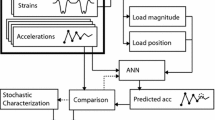Abstract
Presented here is a reality of virtual damage detection and vibration behaviour study of a discrete beam-like bridge with one or several non-propagating edge cracks subjected to a moving vehicle. In this model, the simply supported beam elements are replaced by a range of rigid bars, which are connected by transverse and rotational springs, while the mass and rotational moment of inertia may be lumped at various points along the beam. The adopted vehicle model here is a four degrees-of-freedom, two axes half-vehicle model with tires flexibility and linear suspensions. Damage can be modelled by altering the spring stiffness equation at the crack position according to predictions, which allows the inclusion of simple or complex damage. To simplify, damage is represented here by an open crack, and stiffness of a given element with damage is calculated by fracture mechanics. Both the discrete element and finite element methods are used to investigate vibration analysis of a discrete beam model subjected to a moving vehicle to confirm model feasibility in vibration analysis under a moving vehicle. Besides, some dynamic response laws are obtained. Considering an irregular road profile, the effects of the moving vehicle velocity, the moving vehicle mass, the crack location and the crack depth on dynamic response of a beam-like bridge are analysed by a numerical example, combining a vehicle–bridge coupled vibration MATLAB program with ANSYS. In addition, the neural network is used to identify the damage of the structure. Numerical results of the numerical model predictions, compared with those obtained from the continuous elements beam, support the accuracy of the discrete elements beam model in both cases of undamaged beam and damaged one. The evidence for condition assessment and damage identification of bridge is obtained from this simulation as obtaining the vibrational characteristics of the damaged beam structure subjected to a moving vehicle. And the inversion results show that the neural network method can identify the injury location and injury size of the structure accurately.

















Similar content being viewed by others
References
Bachschmid N, Pennacchi P, Tanzi E (2010) A sensitivity analysis of vibrations in cracked turbogenerator units versus crack position and depth. Mech Syst Signal Process 24(3):844–859
Mazanoglu K, Sabuncu M (2012) A frequency based algorithm for identification of single and double cracked beams via a statistical approach used in experiment. Mech Syst Signal Process 30(1):168–185
Sinou JJ, Faverjon B (2012) The vibration signature of chordal cracks in a rotor system including uncertainties. J Sound Vib 331(1):138–154
Lv Z, Chen G, Zhong C et al (2012) A framework for multi-dimensional webgis based interactive online virtual community. Adv Sci Lett 7(1):215–219
Luczak M, Vecchio A, Peeters B, Gielen L, Auweraer H (2010) Uncertain parameter numerical model updating according to variable modal test data in application of large composite fuselage panel. Shock Vib 17(4):445–459
Shahverdi H, Mares C, Wang W, Mottershead JE (2009) Clus-tering of parameter sensitivities: examples from a helicopter airframe model updating exercise. Shock Vib 16(1):75–87
Mohammed AM, Almansour HH, Martín-Pérez B (2014) Evaluation of dynamic deformations of slab-on-girder bridge under moving trucks with corrosion-damaged columns. Eng Struct 66(1):159–172
Nguyen KV (2013) Comparison studies of open and breathing crack detections of a beam-like bridge subjected to a moving vehicle. Eng Struct 51(1):306–314
Kim S, Kim J (2003) Rotating composite beam with a breathing crack. Compos Struct 60(1):83–90
Parhi DR, Behera AK (1997) Dynamic deflection of a cracked beam with moving mass. Proc Inst Mech Eng C J Mech Eng 211(1):77–87
Fryba L (1999) Vibration of solids and structures under moving loads. Telford, London
Mahmoud MA, AbouZaid MA (2002) Dynamic response of a beam with a crack subject to a moving mass. J Sound Vib 256(4):591–603
Friswell MI, Penny J (2002) Crack modeling for structural health monitoring. Struct Health Monit 1(2):139–148
Rizos PF, Aspragathos N, Dimarogonas AD (1990) Identification of crack location and magnitude in a cantilever beam from the vibration modes. J Sound Vib 138(3):381–388
Narkis Y (1994) Identification of crack location in vibrating simply supported beams. J Sound Vib 172(4):549–558
Bilello C, Bergman LA (2004) Vibration of damaged beams under a moving mass: theory and experimental validation. J Sound Vib 274(3):567–582
Mofid M, Akin JE (1996) Discrete element response of beams with traveling mass. Adv Eng Softw 25(2):323–331
Mofid M, Shadnam M (2000) On the response of beams with internal hinges under moving mass. Adv Eng Softw 31(5):323–328
Yavari A, Nouri M, Mofid M (2002) Discrete element analysis of dynamic response of Timoshenko beams under moving mass. Adv Eng Softw 33(3):143–153
Ziaei-Rad S, Ariae A, Imregun M (2007) Vibration analysis of Timoshenko beams under uniform partially distributed moving masses. J Multi-body Dyn 221(4):551–566
Ariaei A, Ziaei-Rad S, Ghayour M (2009) Vibration analysis of beams with open and breathing cracks subjected to moving masses. J Sound Vib 326(3):709–724
Lv Z, Tek A, Da Silva F et al (2013) Game on, science-how video game technology may help biologists tackle visualization challenges. PLoS ONE 8(3):e57990
Lv Z, Halawani A, Feng S et al (2014) Multimodal hand and foot gesture interaction for handheld devices. ACM Trans Multimed Comput Commun Appl 11(1s):10
Wei W, Fan X, Song H et al (2016) Imperfect information dynamic stackelberg game based resource allocation using hidden markov for cloud computing. IEEE Trans Serv Comput 99:1–10
Mulcahy NL (1983) Bridge response with tractor-trailer vehicle loading. Earthq Eng Struct Dyn 11(5):649–665
Neild SA, McFadden PD, Williams MS (2001) A discrete model of a vibrating beam using a time-stepping approach. J Sound Vib 239(1):99–121
Clough RW, Penzien J (1975) Dynamics of structures. McGraw-Hill, New York
Au FTK, Cheng YS, Cheung YK (2001) Effects of random road surface roughness and long-term deflection of prestressed concrete girder and cable-stayed bridges on impact due to moving vehicles. Comput Struct 79(8):853–872
Honda H, Kajikawa Y, Kobori T (1982) Spectra of road surface roughness on bridges. J Struct Div ASCE 108(9):1956–1966
ISO 8608 (1995) Mechanical vibration-road surface profiles reporting of measured data. ISO, Geneva
Tada H, Paris P, Irwin G (1973) The stress analysis of cracks handbook. Del Research Corporation, Hellertown, Pennsylvania
Lv Z, Halawani A, Feng S et al (2015) Touch-less interactive augmented reality game on vision-based wearable device. Pers Ubiquit Comput 19(3–4):551–567
Wei W, Xu Q, Wang L et al (2014) GI/Geom/1 queue based on communication model for mesh networks. Int J Commun Syst 27(11):3013–3029
Acknowledgements
This work reported here was supported by the National Science Fund of China (51178305 and 51578370) and the Tianjin Research Program of Application Foundation and Advanced Technology (14JCYBJC21500). Any opinions, findings and conclusions or recommendations expressed in this paper are those of the authors and do not necessarily reflect those of the sponsor.
Author information
Authors and Affiliations
Corresponding author
Ethics declarations
Conflict of interest
The authors declare that there is no conflict of interests regarding the publication of this paper.
Rights and permissions
About this article
Cite this article
Xiong, Cb., Lu, Hl. & Zhu, Js. Reality of virtual damage identification based on neural networks and vibration analysis of a damaged bridge under a moving vehicle. Neural Comput & Applic 29, 1331–1341 (2018). https://doi.org/10.1007/s00521-017-2841-y
Received:
Accepted:
Published:
Issue Date:
DOI: https://doi.org/10.1007/s00521-017-2841-y




